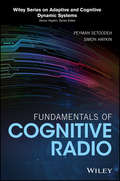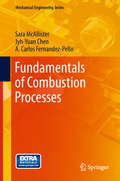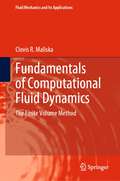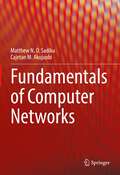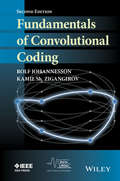- Table View
- List View
Fundamentals of Cognitive Radio (Adaptive and Cognitive Dynamic Systems: Signal Processing, Learning, Communications and Control)
by Peyman Setoodeh Simon HaykinA comprehensive treatment of cognitive radio networks and the specialized techniques used to improve wireless communications The human brain, as exemplified by cognitive radar, cognitive radio, and cognitive computing, inspires the field of Cognitive Dynamic Systems. In particular, cognitive radio is growing at an exponential rate. Fundamentals of Cognitive Radio details different aspects of the human brain and provides examples of how it can be mimicked by cognitive dynamic systems. The text offers a communication-theoretic background, including information on resource allocation in wireless networks and the concept of robustness. The authors provide a thorough mathematical background with data on game theory, variational inequalities, and projected dynamic systems. They then delve more deeply into resource allocation in cognitive radio networks. The text investigates the dynamics of cognitive radio networks from the perspectives of information theory, optimization, and control theory. It also provides a vision for the new world of wireless communications by integration of cellular and cognitive radio networks. This groundbreaking book: Shows how wireless communication systems increasingly use cognition to enhance their networks Explores how cognitive radio networks can be viewed as spectrum supply chain networks Derives analytic models for two complementary regimes for spectrum sharing (open-access and market-driven) to study both equilibrium and disequilibrium behaviors of networks Studies cognitive heterogeneous networks with emphasis on economic provisioning for resource sharing Introduces a framework that addresses the issue of spectrum sharing across licensed and unlicensed bands aimed for Pareto optimality Written for students of cognition, communication engineers, telecommunications professionals, and others, Fundamentals of Cognitive Radio offers a new generation of ideas and provides a fresh way of thinking about cognitive techniques in order to improve radio networks.
Fundamentals of Combustion Engineering
by Achintya Mukhopadhyay Swarnendu SenThis book is an introductory text on fundamental aspects of combustion including thermodynamics, heat and mass transfer and chemical kinetics which are used to systematically derive the basic concepts of combustion. Apart from the fundamental aspects, many of the emerging topics in the field like microscale combustion, combustion dynamics, oxy-fuel combustion and combustion diagnostics are also covered in the book. This would help the beginners in the subject to get initiated to the state of the art topics. Key Features: Coverage of the essential aspects of combustion engineering suitable for both beginners and practicing professionals Topics like entropy generation, microscale combustion, combustion diagnostics, second law-based analysis exclusive to the title Balanced treatment of thermodynamics, transport phenomena and chemical kinetics Discussion on state of the art techniques in combustion diagnostics Illustrates combustion of gaseous, liquid and solid fuels along with emission of pollutants and greenhouse gases
Fundamentals of Combustion Engineering
by Achintya Mukhopadhyay Swarnendu SenThis book is an introductory text on fundamental aspects of combustion including thermodynamics, heat and mass transfer and chemical kinetics which are used to systematically derive the basic concepts of combustion. Apart from the fundamental aspects, many of the emerging topics in the field like microscale combustion, combustion dynamics, oxy-fuel combustion and combustion diagnostics are also covered in the book. This would help the beginners in the subject to get initiated to the state of the art topics. Key Features: Coverage of the essential aspects of combustion engineering suitable for both beginners and practicing professionals Topics like entropy generation, microscale combustion, combustion diagnostics, second law-based analysis exclusive to the title Balanced treatment of thermodynamics, transport phenomena and chemical kinetics Discussion on state of the art techniques in combustion diagnostics Illustrates combustion of gaseous, liquid and solid fuels along with emission of pollutants and greenhouse gases
Fundamentals of Combustion Processes (Mechanical Engineering Series)
by Sara McAllister Jyh-Yuan Chen A. Carlos Fernandez-PelloFundamentals of Combustion Processes is designed as a textbook for an upper-division undergraduate and graduate level combustion course in mechanical engineering. The authors focus on the fundamental theory of combustion and provide a simplified discussion of basic combustion parameters and processes such as thermodynamics, chemical kinetics, ignition, diffusion and pre-mixed flames. The text includes exploration of applications, example exercises, suggested homework problems and videos of laboratory demonstrations
Fundamentals of Computational Fluid Dynamics (Scientific Computation)
by H. Lomax Thomas H. Pulliam David W. ZinggThe chosen semi-discrete approach of a reduction procedure of partial differential equations to ordinary differential equations and finally to difference equations gives the book its distinctiveness and provides a sound basis for a deep understanding of the fundamental concepts in computational fluid dynamics.
Fundamentals of Computational Fluid Dynamics: The Finite Volume Method (Fluid Mechanics and Its Applications #135)
by Clovis R. MaliskaThis book presents the developments of the finite volume method applied to fluid flows, starting from the foundations of the method and reaching the latest approaches using unstructured grids. It helps students learn progressively, creating a strong background on CFD. The text is divided into two parts. The first one is about the basic concepts of the finite volume method, while the second one presents the formulation of the finite volume method for any kind of domain discretization. In the first part of the text, for the sake of simplicity, the developments are done using the Cartesian coordinate system, without prejudice to the complete understanding. The second part extends this knowledge to curvilinear and unstructured grids. As such, the book contains material for introductory courses on CFD for under and graduate students, as well as for more advanced students and researchers.
Fundamentals of Computational Geoscience: Numerical Methods and Algorithms (Lecture Notes in Earth Sciences #122)
by Chongbin Zhao Bruce E. Hobbs Alison OrdGeoscience is a fundamental natural science discipline dealing with the origin, evolutionary history and behaviour of the planet Earth. As a result of its complicated and complex nature, the Earth system not only provides the necessary materials and environment for mankind to live, but also brings many types of natural disasters, such as earthquakes, volcanic eruptions, tsunamis, ?oods and tornadoes, to mention just a few. With the ever-increasing demand for improving our living standards, it has been recognized that the existing natural resources will be exhausted in the near future and that our living environments are, in fact, deteriorating. To maintain the sustainable development of our living standards and the further improvement of our living environments, an inevitable and challenging task that geoscientists are now confronting is how accurately to predict not only the occurrences of these natural disasters, but also the locations of large concealed natural resources in the deep Earth. For this reason, geoscientists must study the processes, rules and laws, by which the Earth system operates, instead of simply describing and observing g- science phenomena.
Fundamentals of Computational Intelligence: Neural Networks, Fuzzy Systems, and Evolutionary Computation (IEEE Press Series on Computational Intelligence)
by James M. Keller Derong Liu David B. FogelProvides an in-depth and even treatment of the three pillars of computational intelligence and how they relate to one another This book covers the three fundamental topics that form the basis of computational intelligence: neural networks, fuzzy systems, and evolutionary computation. The text focuses on inspiration, design, theory, and practical aspects of implementing procedures to solve real-world problems. While other books in the three fields that comprise computational intelligence are written by specialists in one discipline, this book is co-written by current former Editor-in-Chief of IEEE Transactions on Neural Networks and Learning Systems, a former Editor-in-Chief of IEEE Transactions on Fuzzy Systems, and the founding Editor-in-Chief of IEEE Transactions on Evolutionary Computation. The coverage across the three topics is both uniform and consistent in style and notation. Discusses single-layer and multilayer neural networks, radial-basis function networks, and recurrent neural networks Covers fuzzy set theory, fuzzy relations, fuzzy logic interference, fuzzy clustering and classification, fuzzy measures and fuzzy integrals Examines evolutionary optimization, evolutionary learning and problem solving, and collective intelligence Includes end-of-chapter practice problems that will help readers apply methods and techniques to real-world problems Fundamentals of Computational intelligence is written for advanced undergraduates, graduate students, and practitioners in electrical and computer engineering, computer science, and other engineering disciplines.
Fundamentals of Computational Intelligence: Neural Networks, Fuzzy Systems, and Evolutionary Computation (IEEE Press Series on Computational Intelligence)
by James M. Keller Derong Liu David B. FogelProvides an in-depth and even treatment of the three pillars of computational intelligence and how they relate to one another This book covers the three fundamental topics that form the basis of computational intelligence: neural networks, fuzzy systems, and evolutionary computation. The text focuses on inspiration, design, theory, and practical aspects of implementing procedures to solve real-world problems. While other books in the three fields that comprise computational intelligence are written by specialists in one discipline, this book is co-written by current former Editor-in-Chief of IEEE Transactions on Neural Networks and Learning Systems, a former Editor-in-Chief of IEEE Transactions on Fuzzy Systems, and the founding Editor-in-Chief of IEEE Transactions on Evolutionary Computation. The coverage across the three topics is both uniform and consistent in style and notation. Discusses single-layer and multilayer neural networks, radial-basis function networks, and recurrent neural networks Covers fuzzy set theory, fuzzy relations, fuzzy logic interference, fuzzy clustering and classification, fuzzy measures and fuzzy integrals Examines evolutionary optimization, evolutionary learning and problem solving, and collective intelligence Includes end-of-chapter practice problems that will help readers apply methods and techniques to real-world problems Fundamentals of Computational intelligence is written for advanced undergraduates, graduate students, and practitioners in electrical and computer engineering, computer science, and other engineering disciplines.
Fundamentals of Computer-Aided Circuit Simulation (The Springer International Series in Engineering and Computer Science #37)
by William J. McCallaFrom little more than a circuit-theoretical concept in 1965, computer-aided circuit simulation developed into an essential and routinely used design tool in less than ten years. In 1965 it was costly and time consuming to analyze circuits consisting of a half-dozen transistors. By 1975 circuits composed of hundreds of transistors were analyzed routinely. Today, simulation capabilities easily extend to thousands of transistors. Circuit designers use simulation as routinely as they used to use a slide rule and almost as easily as they now use hand-held calculators. However, just as with the slide rule or hand-held calculator, some designers are found to use circuit simulation more effectively than others. They ask better questions, do fewer analyses, and get better answers. In general, they are more effective in using circuit simulation as a design tool. Why? Certainly, design experience, skill, intuition, and even luck contribute to a designer's effectiveness. At the same time those who design and develop circuit simulation programs would like to believe that their programs are so easy and straightforward to use, so well debugged and so efficient that even their own grandmother could design effectively using their program.
Fundamentals of Computer Architecture and Design
by Ahmet BindalThis textbook provides semester-length coverage of computer architecture and design, providing a strong foundation for students to understand modern computer system architecture and to apply these insights and principles to future computer designs. It is based on the author’s decades of industrial experience with computer architecture and design, as well as with teaching students focused on pursuing careers in computer engineering. Unlike a number of existing textbooks for this course, this one focuses not only on CPU architecture, but also covers in great detail in system buses, peripherals and memories. This book teaches every element in a computing system in two steps. First, it introduces the functionality of each topic (and subtopics) and then goes into “from-scratch design” of a particular digital block from its architectural specifications using timing diagrams. The author describes how the data-path of a certain digital block is generated using timing diagrams, a method which most textbooks do not cover, but is valuable in actual practice. In the end, the user is ready to use both the design methodology and the basic computing building blocks presented in the book to be able to produce industrial-strength designs.
Fundamentals of Computer Architecture and Design
by Ahmet BindalThis textbook provides semester-length coverage of computer architecture and design, providing a strong foundation for students to understand modern computer system architecture and to apply these insights and principles to future computer designs. It is based on the author’s decades of industrial experience with computer architecture and design, as well as with teaching students focused on pursuing careers in computer engineering. Unlike a number of existing textbooks for this course, this one focuses not only on CPU architecture, but also covers in great detail in system buses, peripherals and memories. This book teaches every element in a computing system in two steps. First, it introduces the functionality of each topic (and subtopics) and then goes into “from-scratch design” of a particular digital block from its architectural specifications using timing diagrams. The author describes how the data-path of a certain digital block is generated using timing diagrams, a method which most textbooks do not cover, but is valuable in actual practice. In the end, the user is ready to use both the design methodology and the basic computing building blocks presented in the book to be able to produce industrial-strength designs.
Fundamentals of Computer Networks
by Matthew N. Sadiku Cajetan M. AkujuobiThis textbook presents computer networks to electrical and computer engineering students in a manner that is clearer, more interesting, and easier to understand than other texts. All principles are presented in a lucid, logical, step-by-step manner. As much as possible, the authors avoid wordiness and giving too much detail that could hide concepts and impede overall understanding of the material. Ten review questions in the form of multiple-choice objective items are provided at the end of each chapter with answers. The review questions are intended to cover the little “tricks” which the examples and end-of-chapter problems may not cover. They serve as a self-test device and help students determine how well they have mastered the chapter.
Fundamentals of Computer Organization and Design (Texts in Computer Science)
by Sivarama P. DandamudiA new advanced textbook/reference providing a comprehensive survey of hardware and software architectural principles and methods of computer systems organization and design. The book is suitable for a first course in computer organization. The style is similar to that of the author's book on assembly language in that it strongly supports self-study by students. This organization facilitates compressed presentation of material. Emphasis is also placed on related concepts to practical designs/chips. Topics: material presentation suitable for self- study; concepts related to practical designs and implementations; extensive examples and figures; details provided on several digital logic simulation packages; free MASM download instructions provided; and end-of-chapter exercises.
Fundamentals of Conjugated Polymer Blends, Copolymers and Composites: Synthesis, Properties, and Applications
by Parveen SainiSince their discovery in 1977, the evolution of conducting polymers has revolutionized modern science and technology. These polymers enjoy a special status in the area of materials science yet they are not as popular among young readers or common people when compared to other materials like metals, paper, plastics, rubber, textiles, ceramics and composites like concrete. Most importantly, much of the available literature in the form of papers, specific review articles and books is targeted either at advanced readers (scientists/technologists/engineers/senior academicians) or for those who are already familiar with the topic (doctoral/postdoctoral scholars). For a beginner or even school/college students, such compilations are bit difficult to access/digest. In fact, they need proper introduction to the topic of conducting polymers including their discovery, preparation, properties, applications and societal impact, using suitable examples and already known principles/knowledge/phenomenon. Further, active participation of readers in terms of “question & answers”, “fill-in-the-blanks”, “numerical” along with suitable answer key is necessary to maintain the interest and to initiate the “thought process”. The readers also need to know about the drawbacks and any hazards of such materials. Therefore, I believe that a comprehensive source on the science/technology of conducting polymers which maintains a link between grass root fundamentals and state-of-the-art R&D is still missing from the open literature.
Fundamentals of Conjugated Polymer Blends, Copolymers and Composites: Synthesis, Properties, and Applications
by Parveen SainiSince their discovery in 1977, the evolution of conducting polymers has revolutionized modern science and technology. These polymers enjoy a special status in the area of materials science yet they are not as popular among young readers or common people when compared to other materials like metals, paper, plastics, rubber, textiles, ceramics and composites like concrete. Most importantly, much of the available literature in the form of papers, specific review articles and books is targeted either at advanced readers (scientists/technologists/engineers/senior academicians) or for those who are already familiar with the topic (doctoral/postdoctoral scholars). For a beginner or even school/college students, such compilations are bit difficult to access/digest. In fact, they need proper introduction to the topic of conducting polymers including their discovery, preparation, properties, applications and societal impact, using suitable examples and already known principles/knowledge/phenomenon. Further, active participation of readers in terms of “question & answers”, “fill-in-the-blanks”, “numerical” along with suitable answer key is necessary to maintain the interest and to initiate the “thought process”. The readers also need to know about the drawbacks and any hazards of such materials. Therefore, I believe that a comprehensive source on the science/technology of conducting polymers which maintains a link between grass root fundamentals and state-of-the-art R&D is still missing from the open literature.
Fundamentals of Construction Claims: A 9-Step Guide for General Contractors, Subcontractors, Architects, Engineers, and Owners
by William J. McConnellDemystify complicated construction claims with this indispensable guide Given how common complex claims have become in the modern built environment, Fundamentals of Construction Claims: A 10-Step Guide for General Contractors, Subcontractors, Architects and Engineers is an absolutely critical addition to the library of any construction professional. Written by William J. McConnell, PE, JD, MSCE, CDT, a celebrated, lawyer, author, engineer, and expert witness, Fundamentals of Construction Claims sets out clear and concrete strategies for developing a construction claim from beginning to end. The author's straightforward 10-Step method helps readers avoid costly dispute resolution fees by: Explaining entitlement requirements for various types of claims, including differing site conditions, added scope, and weather delays Offering procedures for calculating delay impacts through forensic scheduling analysis Defining, in detail, four simple ways to prove damages Throughout, relevant case studies are used to illuminate the principles found within and bring life to the concepts the author introduces.
Fundamentals of Construction Claims: A 9-Step Guide for General Contractors, Subcontractors, Architects, Engineers, and Owners
by William J. McConnellDemystify complicated construction claims with this indispensable guide Given how common complex claims have become in the modern built environment, Fundamentals of Construction Claims: A 10-Step Guide for General Contractors, Subcontractors, Architects and Engineers is an absolutely critical addition to the library of any construction professional. Written by William J. McConnell, PE, JD, MSCE, CDT, a celebrated, lawyer, author, engineer, and expert witness, Fundamentals of Construction Claims sets out clear and concrete strategies for developing a construction claim from beginning to end. The author's straightforward 10-Step method helps readers avoid costly dispute resolution fees by: Explaining entitlement requirements for various types of claims, including differing site conditions, added scope, and weather delays Offering procedures for calculating delay impacts through forensic scheduling analysis Defining, in detail, four simple ways to prove damages Throughout, relevant case studies are used to illuminate the principles found within and bring life to the concepts the author introduces.
Fundamentals of Continuum Mechanics of Soils
by Yehuda KlausnerFundamentals of Continuum Mechanics of Soils provides a long-needed general scheme for the study of the important yet problematic material of soil. It closes the gap between two disciplines, soil mechanics and con- tinuum mechanics, showing that the familiar concepts of soil mechanics evolve directly from continuum mechanics. It confirms concepts such as pore pressures, cohesion and dependence of the shear stress on consolidation, and rejects the view that continuum mechanics cannot be applied to a material such as soil. The general concepts of continuum mechanics, field equations and constitutive equations are discussed. It is shown how the theory of mixtures evolves from these equations and how, along with energetics and irrevers- ible thermodynamics, it can be applied to soils. The discussion also sheds light on some aspects of mechanics of materials, especially compressible materials. Examples are the introduction of the Hencky measure of strain, the requirement of dual constitutive equations, and the dependence of the spent internal energy on the stored internal energy. Researchers in engineering mechanics and material sciences may find that the results of experiments on soils can be generalized and extended to other materials. The book is a reference text for students familiar with the fundamentals of mechanics, for scholars of soil engineering, and for soil scientists. It is also suitable as an advanced undergraduate course in soil mechanics.
Fundamentals of Convective Heat Transfer
by Vijay K. Dhir Gautam Biswas Amaresh DalalThermal convection is often encountered by scientists and engineers while designing or analyzing flows involving exchange of energy. Fundamentals of Convective Heat Transfer is a unified text that captures the physical insight into convective heat transfer and thorough, analytical, and numerical treatments. It also focuses on the latest developments in the theory of convective energy and mass transport. Aimed at graduates, senior undergraduates, and engineers involved in research and development activities, the book provides new material on boiling, including nuances of physical processes. In all the derivations, step-by-step and systematic approaches have been followed.
Fundamentals of Convective Heat Transfer
by Vijay K. Dhir Gautam Biswas Amaresh DalalThermal convection is often encountered by scientists and engineers while designing or analyzing flows involving exchange of energy. Fundamentals of Convective Heat Transfer is a unified text that captures the physical insight into convective heat transfer and thorough, analytical, and numerical treatments. It also focuses on the latest developments in the theory of convective energy and mass transport. Aimed at graduates, senior undergraduates, and engineers involved in research and development activities, the book provides new material on boiling, including nuances of physical processes. In all the derivations, step-by-step and systematic approaches have been followed.
Fundamentals of Convolutional Coding (IEEE Series on Digital & Mobile Communication)
by Rolf Johannesson Kamil Sh. ZigangirovFundamentals of Convolutional Coding, Second Edition, regarded as a bible of convolutional coding brings you a clear and comprehensive discussion of the basic principles of this field Two new chapters on low-density parity-check (LDPC) convolutional codes and iterative coding Viterbi, BCJR, BEAST, list, and sequential decoding of convolutional codes Distance properties of convolutional codes Includes a downloadable solutions manual
Fundamentals of Convolutional Coding (IEEE Series on Digital & Mobile Communication)
by Rolf Johannesson Kamil Sh. ZigangirovFundamentals of Convolutional Coding, Second Edition, regarded as a bible of convolutional coding brings you a clear and comprehensive discussion of the basic principles of this field Two new chapters on low-density parity-check (LDPC) convolutional codes and iterative coding Viterbi, BCJR, BEAST, list, and sequential decoding of convolutional codes Distance properties of convolutional codes Includes a downloadable solutions manual
Fundamentals of Crystal Growth I: Macroscopic Equilibrium and Transport Concepts (Springer Series in Solid-State Sciences #5)
by Franz E. RosenbergerThe intrinsic properties of a solid, i. e. , the properties that result from its specific structure, can be largely modified by crystallographic and chem ical defects. The formation of these defects is governed by the heat and mass transfer conditions which prevail on and near a crystal-nutrient in terface during crystallization. Hence, both the growth of highly perfect crystals and the preparation of samples having predetermined defect-induced (extrinsic) properties require a thorough understanding of the reaction and transport mechanisms that govern crystallization from vapors, solutions and melts. Crystal growth, as a science, is therefore mostly concerned with the chemistry and physics of heat and mass transport in these fluid-solid phase transitions. Solid-solid transitions are, at this time, not widely employed for high quality single-crystal production. Transport concepts are largely built upon equilibrium considerations, i. e. , on thermodynamic and phase equilibrium concepts. Hence to supply a "workable" foundation for the succeeding discussions, this text begins in Chapter 2 with a concise treatment of thermodynamics which emphasizes applications to mate rials preparation. After working through this chapter, the reader should feel at ease with often (particularly among physicists) unfamiliar entities such as chemical potentials, fugacities, activities. etc. Special sections on ther mochemical calculations (and their pitfalls) and compilations of thermochemi cal data conclude the second chapter. Crystal growth can be called. in a wide sense, the science and technology of controlling phase transitions that lead to (single crystalline) solids.
Fundamentals of Crystallography, Powder X-ray Diffraction, and Transmission Electron Microscopy for Materials Scientists (Advances in Materials Science and Engineering)
by Dong ZhiLiThe structure–property relationship is a key topic in materials science and engineering. To understand why a material displays certain behaviors, the first step is to resolve its crystal structure and reveal its structure characteristics. Fundamentals of Crystallography, Powder X-ray Diffraction, and Transmission Electron Microscopy for Materials Scientists equips readers with an in-depth understanding of using powder x-ray diffraction and transmission electron microscopy for the analysis of crystal structures. Introduces fundamentals of crystallography Covers XRD of materials, including geometry and intensity of diffracted x-ray beams and experimental methods Describes TEM of materials and includes atomic scattering factors, electron diffraction, and diffraction and phase contrasts Discusses applications of HRTEM in materials research Explains concepts used in XRD and TEM lab training Based on the author’s course lecture notes, this text guides materials science and engineering students with minimal reliance on advanced mathematics. It will also appeal to a broad spectrum of readers, including researchers and professionals working in the disciplines of materials science and engineering, applied physics, and chemical engineering.
